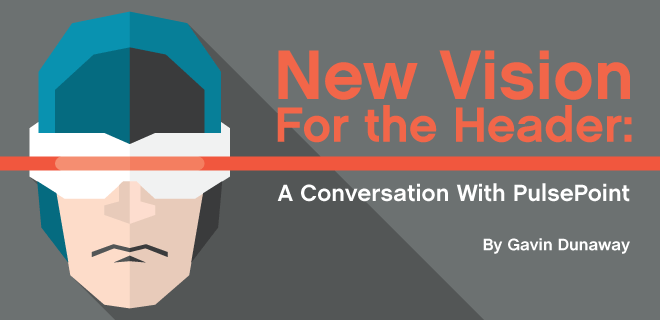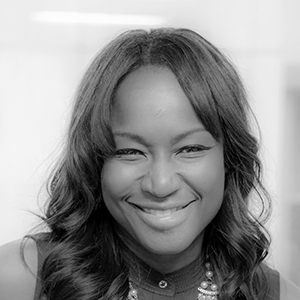
In the relatively brief amount of time since digital publishers have adopted header bidding en masse, the header has become jam-packed with demand partners. With new header solutions being built each day, publishers are now wondering how to manage—from who to let into their header to what criteria is available to evaluate performance to how to best maximize revenue.
Header bidding was originally meant, in part, to provide a means for preferred partners to have equal footing and to bypass the programmatic waterfall. However, now many header-happy publishers find themselves navigating a new waterfall within the header itself.
The success of header bidding has created the need to give publishers more insight and control so they can optimize their monetization. Enter PulsePoint Vision, a solution to give publishers a clear line of sight for all partner bids and across all formats on the entire page—via a header-based server-to-server connection. Recently PulsePoint Chief Operating Officer Darline Jean sat down with Gavin Dunaway to talk about Vision and how header bidding will be just one step in the path toward the promised land of holistic monetization.
GAVIN DUNAWAY: What publisher challenges was Vision built to solve? It seems to be an extension of PulsePoint’s multi-format monetization technology.
DARLINE JEAN: Header bidding was a focus for us in 2016 and we quickly saw a need to move beyond the initial gains of unified auctions only for display. A publisher’s concern is twofold: One, providing engaging content to increase the user base; two, optimally monetizing every single page. We solved the later with Vision.
The concept behind Vision was to create a platform which provides publishers with a clear line of sight so they can use one platform to manage operations across multiple demand sources to seamlessly maximize revenue from every unit on their pages.
With Vision, publishers can now monetize multiple creative formats simultaneously, manage revenue strategy down to the site, section and page level to and access cutting edge analytics across the entire bid landscape, taking header bidding to the next level.
Other platforms in the market offer limited ad formats and still require publishers to work across and manage multiple sources to get a true sense of their business performance. Vision has solved the pain points associated with this.
GD: To illustrate what this means, let’s say PulsePoint delivers a high winning bid for a vertical banner, but another header partner delivers a higher bid on a horizontal unit. Could the pub leverage both?
 DJ: Absolutely. The platform is both partner and ad unit agnostic to give full control back to the publisher and will offer the highest bids for every unit on the page, independent of who the bidder is.
DJ: Absolutely. The platform is both partner and ad unit agnostic to give full control back to the publisher and will offer the highest bids for every unit on the page, independent of who the bidder is.
Vision looks at all ad formats—display, instream and outstream video, and in-image—and picks the ad with the highest-CPM, and sends that to the server. Vision also takes analytics a step further with page controls that allow a publisher’s ad ops team to assign different criteria all the way down to the page level.
Publishers can set different floor prices, brand exclusions, choice of ad format or timeouts for different pages or segments on the page based on business objectives to strategically optimize revenue. This is done via header bidding code in a server-to server connection.
GD: Google is making a play with Exchange Bidding in Dynamic Allocation (EBDA). What kind of effect do you think that’ll have on the space?
DJ: I think if they’d done it two years ago, it would be huge. Google had Dynamic Allocation before header bidding exploded in popularity. But now that so many publishers have onboarded header bidding partners are seeing such a nice increase, competing against AdX head-on. They’ll be reluctant to get rid of header tags and just go back to AdX or succumb to building waterfalls within a header bidding paradigm.
The idea with Vision was to eliminate the waterfall, not create a new waterfall within header bidding.
GD: We’ve postulated that Google’s Dynamic Allocation drove the rise of header bidding.
DJ: And the publishers are going to confirm that. If it was a year and a half ago, I think EBDA would be much more meaningful.
GD: It’s interesting to bring up the new waterfall. What do you think is the next step?
DJ: When publishers first roll out header bidding, it’s great to deal with multiple partners and then eliminate those who are not performing to their needs. Vision provides publishers with the information to make that decision: “I don’t need partner A, because all of my revenue is coming from partner B. Latency timeouts are a problem I’m seeing from partner C. I need to eliminate that…”
GD: I think I know some publishers that will keep multiple header integrations at least for a while, because some people enjoy the yield management of it.
DJ: Some of them might be afraid to eliminate partners—they worry if it is worth unplugging them and the potential hassle of reintegrating later. Or, a partner may not be performing well now, but what happens if they start doing better two months from now?
GD: The big trend that we are starting to see, and maybe this is more theoretical than anything else, is real-time guaranteed or programmatic guaranteed, where you’re guaranteeing campaigns that are executed programmatically.
DJ: I would say that’s not a 2017 trend; that’s a 2016 trend that will continue in 2017. But as a publisher, to benefit from this, you have to offer something more creative for advertisers, or else they can buy the same inventory programmatically. What will drive CPMs is the use of data to reach the user much more accurately on multiple sites.
GD: It seems like everybody and their grandmother is putting out a header bidder now. Do you think 2017 will see a bit of consolidation in the space?
DJ: Yes. Consolidation was a big trend in 2016, and it will continue in 2017.
GD: What are you most excited about in 2017? What are you guys hoping to build up?
DJ: In addition to Vision, in 2017 we will continue to focus on key initiatives, such as header bidding, video, strategic partnerships with premium publishers and brands, and our new health-specific offering. We are also aggressively exploring M&A opportunities, which is always exciting!